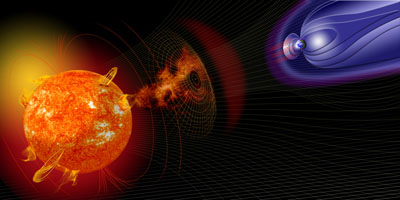NASA's Solar Dynamics Observatory (SDO) captured this image of an M7.9 class flare on 13 March 2012 at 1.29 pm EDT. It is shown here in the 131 Angstrom wavelength. Image by NASA/SDO
Sunspot 1429 remains active, after the sun erupted with an M7.9-class flare yesterday from the same region that has been producing flares and coronal mass ejections all week, space agency NASA reported.
Last week, NASA had suggested that high-frequency radio communications, GPS and power grids could have been impacted by two coronal mass ejections (CMEs) that were hurling towards Earth. On 6 March, the sun erupted with one of the largest solar flares of this solar cycle. However, the solar storm passed without any major incident. NASA had also indicated at the time that CME would also induce auroras at low latitudes.
However, NASA did say at the time that the solar flare of 6 March “triggered a temporary radio blackout on the sunlit side of Earth that interfered with radio navigation and short-wave radio,” said the space agency.
Solar maximum in 2013
Utilities and telcos are especially keeping a close eye on the sun’s activities this year, as the sun is set to reach its solar maximum, potentially in late 2013, according to NASA scientists.
Yesterday at around 5.29pm Universal Time, NASA’s Solar Dynamics Observatory (SDO) captured an image of the M7.9 class flare. Sunspot 1429 has been generating many major solar storms of late.

Artist’s illustration of events on the sun changing the conditions in near-Earth space. Image by NASA
So what exactly happens following an eruption on the sun?
Space weather starts with an eruption on the sun, such as a burst of light and radiation called a solar flare or a gigantic cloud of solar material, a CME, according to NASA.
NASA describes a solar flare as an explosion on the sun that happens when energy stored in twisted magnetic fields (usually above sunspots) is suddenly released.
But the effects of those eruptions happen at Earth, or at least near-Earth space, said NASA.
Solar burps
Such flares produce a burst of radiation across the electromagnetic spectrum, ranging from radio waves to X-rays and gamma rays.
Massive bursts of solar wind, (the CMEs), or ‘solar burps’, are associated with solar flares.
There are three categories of solar flares: x-class flares are big and can trigger planet-wide radio blackouts and long-lasting radiation storms. M-class flares are medium sized and can cause brief radio blackouts that affect Earth’s polar regions. C-class flares are small and have few noticeable consequences for planet Earth, NASA said.
Solar storms
A geomagnetic or solar storm refers to any time Earth’s magnetic environment, the magnetosphere, undergoes sudden and repeated change. NASA said magnetic fields continually re-align, while energy “dances quickly” from one area to another during such a solar storm.
Geomagnetic storms occur when certain types of CMEs connect with the outside of the magnetosphere for an extended period of time.
Solar superstorm of 1859
The strongest solar storm ever recorded happened on 1-2 September 1859. It caused aurorae to be seen all over the world, while telegraph systems in Europe and North America also failed, with pylons emitting sparks. British astronomer Richard Carrington and Richard Hodgson were the first scientists to independently make observations of a solar flare during the 1859 storm when they viewed a large flare in white light.